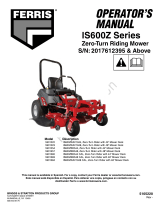
8
• Ground speed levers are not locked in their START /
PARK positions.
TEST 2 - Engine should crank if:
• PTO switch is NOT engaged, AND,
• Ground speed levers are locked in their START / PARK
positions.
TEST 3 - Engine must shut off if:
• Operator rises off seat with PTO engaged, OR
• Operator rises off seat with ground speed levers not
locked in their START / PARK positions.
TEST 4 - Check mower blade stopping time
The mower blades and mower drive belt should come to
a complete stop within five seconds after the electric PTO
switch is turned off. If mower drive belt does not stop within
five seconds, see your dealer.
Note:Once the engine has stopped, the PTO switch must
be turned off and the ground speed levers must be locked in
their START/PARK positions in order to start the engine.
Oil Recommendations
Oil Capacity:See theSpecificationssection.
We recommend the use of Briggs & Stratton®Warranty
Certified oils for best performance. Other high-quality
detergent oils are acceptable if classified for service SF, SG,
SH, SJ or higher. Do not use special additives.
Outdoor temperatures determine the proper oil viscosity for
the engine. Use the chart to select the best viscosity for the
outdoor temperature range expected.
A SAE 30 -Below 40 °F (4 °C) the use of SAE 30 will result in hard
starting.
B 10W-30 -Above 80 °F (27 °C) the use of 10W-30 may cause
increased oil consumption. Check oil level more frequently.
C Synthetic 5W-30
D 5W-30
Check Oil Level
See Figure: 4
Before adding or checking the oil
• Make sure the engine is level.
• Clean the oil fill area of any debris.
1. Remove the dipstick (A, Figure 4) and wipe with a clean
cloth.
4
2. Install and tighten the dipstick (A, Figure 4).
3. Remove the dipstick and check the oil level. Correct oil
level is at the top of the full indicator (B, Figure 4) on the
dipstick.
4. If oil level is low, slowly add oil into the engine oil fill
(C, Figure 4). Do not overfill. After adding oil, wait one
minute and then recheck the oil level.
Note:Do not add oil at the quick oil drain , if equipped. For
location, see Features and Controls.
5. Reinstall and tighten the dipstick (A, Figure 4).
Oil Pressure
If the oil pressure is too low, a pressure switch (if equipped)
will either stop the engine or activate a warning device on the
equipment. If this occurs, stop the engine and check the oil
level with the dipstick.
If the oil level is below the ADD mark, add oil until it touches
the FULL mark. Start the engine and check for the correct oil
pressure before you continue to operate the machine.
If the oil level is between the ADD and FULL marks,DO NOT
start the engine. Contact an authorized service dealer to
correct the oil pressure problem.
Fuel Recommendations
Fuel must meet these requirements:
• Clean, fresh, unleaded gasoline.
• A minimum of 87 octane / 87 AKI (91 RON). For high
altitude use, see below.
• Gasoline with up to 10% ethanol (gasohol) is acceptable.
NOTICE Do not use unapproved gasolines, such as E15
and E85. Do not mix oil in gasoline or modify the engine to
run on alternate fuels. Use of unapproved fuels will cause
damage to engine components, which will not be covered
under warranty.
To protect the fuel system from gum formation, mix a fuel
stabilizer into the fuel. See the appropriate Operator's





















